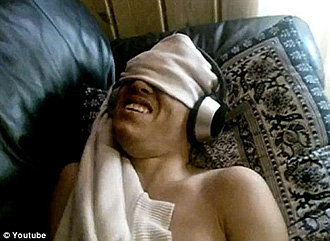
|  |  |  Technology News Technology News  
I-Dosing: How Teenagers Are Getting 'Digitally High' From Music They Download From Internet
 Daniel Bates - Daily Maik UK Daniel Bates - Daily Maik UK
go to original
July 22, 2010


| | Reaction: A teenage boy looks in a state of distress as he listens to an 'I-Dose' | 
| | Pain: The I-Dose sensation does not look pleasant as a girl videos herself writhing | 
| | Freak out: This teenager screwed up his face and shook as he listened to a track |  |
They put on their headphones, drape a hood over their head and drift off into the world of ‘digital highs’.

Videos posted on YouTube show a young girl freaking out and leaping up in fear, a teenager shaking violently and a young boy in extreme distress.

This is the world of ‘i-Dosing’, the new craze sweeping the internet in which teenagers used so-called ‘digital drugs’ to change their brains in the same way as real-life narcotics.

They believe the repetitive drone-like music will give them a ‘high’ that takes them out of reality, only legally available and downloadable on the Internet.

The craze has so far been popular among teenagers in the U.S. but given how easily available the videos are, it is just a matter of time before it catches on in Britain.

Those who come up with the ‘doses’ claim different tracks mimic different sensations you can feel by taking drugs such as Ecstasy or smoking cannabis.

The reactions have been partially sceptical but some songs have become wildly popular, receiving nearly half a million hits on YouTube.

Under one called ‘Shroom’, Berecz wrote: ‘just listened to this... at the beginning I began to see some blinking light (while eyes closed), then the pitch went up and I began to feel that Im sinking into my chair...as the pitch went down I began to feel confident, and very relaxed, and I dont want to stand up from my chair and I dont want to say any words...’

Not everyone is taking i-Dosing seriously - some YouTube videos show young adults ‘i-Dosing’ on Neil Diamond and mocking the whole phenomenon.

But there has been such alarm in the U.S. that the Oklahoma Bureau of Narcotics and Dangerous Drugs has issued a warning to children not to do it.

‘Kids are going to flock to these sites just to see what it is about and it can lead them to other places, spokesman Mark Woodward said.

He added that parental awareness is key to preventing future problems, since I-dosing could indicate a willingness to experiment with drugs.

‘So that's why we want parents to be aware of what sites their kids are visiting and not just dismiss this as something harmless on the computer.

‘If you want to reach these kids, save these kids and keep these kids safe, parents have to be aware. They've got to take action.’

He added that another concern is that many of these I-dosing sites lure visitors to actual drug and drug paraphernalia sites.

Schools in the Mustang area recently sent out a letter warning parents about the new trend after several high school students reported having physiological effects after trying one of these digital downloads.

‘We had never come across anything like this and anything that is going to cause these physiological effects in a student, that causes us concern,’ said Shannon Rigsby, Mustang Public Schools Communication Officer.

I-Dosing tracks have imposing names such as ‘Gates of Hades’ or ‘Hand of God’ which are ten minutes long - some sound like a ship’s horn being repeated again and again whilst others are more abrasive and resemble cheap synthesizers being played very fast.

But although they use a very modern method of spreading themselves, i-Dosing is actually a variation on a very old method of achieving an altered state.

In 1839 German physicist Heinrich Wilhelm Dove found that two tones played at slightly different frequencies in each ear makes the listener think they are hearing a quick beat.

He called the phenomenon ‘binaural beats’, and it has been the subject of research in the two centuries since.

Binaural beat therapy is used in clinical settings to research hearing and sleep cycles, to induce various brain wave states, and treat anxiety.

Dr Helane Wahbeh, a Naturopathic Physician and Clinician Researcher at the Oregon Health and Science University, said: 'Binaural beats happen when opposite ears receive two different sound waves.

‘And normally, the difference in sound between each ear help people get directional information about the source of the sound.

‘But when you listen to these sounds with stereo headphones, the listener senses the difference between the two frequencies as another beat that sounds like it's coming from the inside of the head.’

But Dr Wahbeh denied there was any possibility that someone could experience similar effects to cocaine or ecstasy.

She said: 'We did a small controlled study with four people, and we did not see any brain wave activity shifting to match the binaural beat that people were listening to.’

However, other researchers say the ‘high’ listeners claim to feel may actually be a placebo effect determined by the individual’s desire to feet it.
|

 |
|  |



